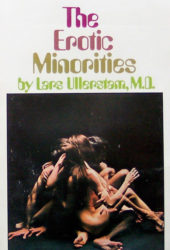 Erotic Minorities
Erotic Minorities
by Lars Ullerstam
Published by Grove Press
Published 1966
Sociology
172 pgs. • Find on Amazon.com
Reviewed by Vern L. Bullough
March 11, 1966
No sooner is one set of taboos removed than there are others which demand attention. At least part of Lars Ullerstam’s thesis is that homosexuals are now the most fortunately placed of what he calls either the “sexual eccentrics” or the “erotic minority.” Homosexuals can have their own clubs, can publicly announce their identity, and can even have a favorable press for their beliefs. This, he claims, is not the case for other members of the “erotic minority” and he attempts to plead their cause with the public.
Ullerstam makes a general, pseudoscientific survey of many different types of sex attitudes which he separates from homosexuality. He devotes sections to incest, exhibitionism, pedophilia, saliromania (the urge to defile), algolagnia (a term which he uses to include both sadism and masochism), scopophilia (voyeurism), transvestism, festishism, necrophilism, sodomy, sexual collectivism, pyromania, et al. He does not claim to have done any original research but throws in references to Kinsey and other studies.

The book was obviously written for a Scandinavian audience. Even though the work has been translated into English, most of the legal references are to Scandinavian law and interpretations. Since Scandinavian and English (or American) law are totally different, his book, at least as far as the legal discussion is concerned, has little immediate value for Americans. Even in his discussion on literature, much of the material would be foreign to the college-educated, English speaking person. The most serious failure of the book, however, is in its prescription for sexual reforms. His prime solution is public education about sexual diversity beginning with children. Just how the public would be made receptive to this is not clear. He also urges the establishment of bureaus where people with complimentary urge patterns could meet one another, the opening of newspaper classified columns to sex needs, the organization of private clubs for exhibitionists, improvement of pornographic social services, the licensing of brothels, et al. In effect, he tries to cover the waterfront without really stopping to think how practical or political or effective some of his suggestions might be.
As a sympathetic plea for understanding, Ullerstam deserves to be read, but for a logical case for changing the laws, Ullerstam can only be regarded as a beginning. There is still a need for more research and scholarly studies.
Vern L. Bullough is professor of history at San Fernando Valley State College.
© 1966, 2016 by The Tangent Group. All rights reserved.

